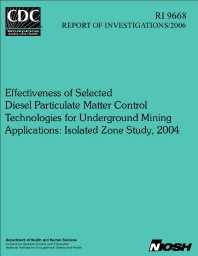Mining Publication: Effectiveness of Selected Diesel Particulate Matter Control Technologies for Underground Mining Applications: Isolated Zone Study, 2004
Original creation date: August 2006
The National Institute for Occupational Safety and Health conducted a study to determine the effects of selected, state-of-the-art emission control technologies on the ambient concentrations of particulate matter and gases emitted by underground diesel-powered mining equipment. Tests were conducted in an isolated zone of an underground mine to evaluate the effectiveness of alternative fuel formulations, namely, water-fuel emulsions, blended biodiesel fuels, ultralow sulfur diesel fuel, and #1 diesel; and selected exhaust aftertreatment devices, namely, diesel oxidation catalysts (DOCs), diesel particulate filter (DPF) systems, and filtration systems designed around high-temperature disposable filter elements. The results showed that using a cold-weather and warm-weather water-fuel emulsion formulation reduced mass concentrations of elemental carbon (EC) by about 70% and 85%, respectively. The 20% and 50% soy biodiesel blends reduced EC by 49% and 66%, respectively. The reductions were slightly less pronounced for the 20% and 50% yellow grease biodiesel blends-33% and 56%, respectively. EC concentrations were unaffected by using ultralow sulfur diesel in place of #1 diesel. Use of the reformulated fuels did not substantially alter the concentrations of nitric oxide and carbon monoxide. However, a measurable increase in the nitrogen dioxide (NO2) peak concentration was observed during the biodiesel tests. The ArvinMeritor (AM) fuel-burner DPF system with a palladium-catalyzed DOC reduced EC concentrations by 92%. The diesel filter elements from Donaldson Co., Inc., and Filter Service & Testing Corp. reduced the EC concentration of the mine air by 92% and 70%, respectively. When the palladium-based DOC was used with the AM DPF, it raised the average and peak downstream NO2 concentrations by a factor of three. Tests of the AM DPF system with a platinum-catalyzed DOC and CAP/ETG catalytic particulate oxidizer system had to be terminated because the elevated NO2 concentrations threatened to overexpose the operator. The tests with only a selected DOC also resulted in increased NO2 concentrations in mine air.
Authors: AD Bugarski, GH Schnakenberg, SE Mischler, JD Noll, LD Patts, JA Hummer
Report of Investigations - August 2006
NIOSHTIC2 Number: 20030929
U.S. Department of Health and Human Services, Public Health Service, Centers for Disease Control and Prevention, National Institute for Occupational Safety and Health, DHHS (NIOSH) Pub. No. 2006-138, Report of Investigations 9668, 2006 Aug; :1-77
See Also
- Control Technologies and Strategies for Reducing Exposure of Underground Miners to Diesel Emissions
- DEEP Project on Evaluation of Diesel Particulate Filters at Inco's Stobie Mine
- Diesel Emissions Control Technologies in Coal Mines
- Diesel Emissions Control Technologies in Metal/Nonmetal Mines
- Effects of Diesel Exhaust Aftertreatment Devices on Concentrations and Size Distribution of Aerosols in Underground Mine Air
- The Effects of Passive Diesel Particulate Filters on Diesel Particulate Matter Concentrations in Two Underground Metal/Nonmetal Mines
- Effects of Sintered Metal Diesel Particulate Filter System on Diesel Aerosols and Nitric Oxides in Mine Air
- Emissions from a Diesel Engine using Fe-based Fuel Additives and a Sintered Metal Filtration System
- Evaluation of the SKC® DPM Cassette for Monitoring Diesel Particulate Matter in Coal Mines
- Mutagenicity of Diesel Exhaust Particles from an Engine with Differing Exhaust After Treatments
- Content source: National Institute for Occupational Safety and Health, Mining Program


 ShareCompartir
ShareCompartir
